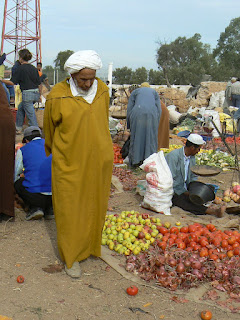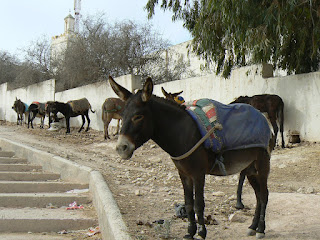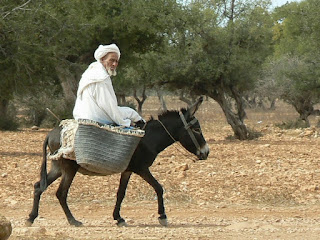It was foggy when we got here which made wandering around the medina fun and mysterious. Essaouria is a very friendly town, much more so than Marrakech. Many of the men dress in long, green robes and knit caps and many of the women wear brightly colored flowing robes. The air smells of sea salt, spices and grilled fish.
Carpet shops and little workshops are tucked into alleys where craftsmen use the local wood to make drums and inlaid boxes. There's a Cafe de France, of course, on the main square, where we spent a relaxing hour or so drinking mint tea and watching the local women walk arm in arm in the afternoon. The scene reminded me of the Italian passagiatta.
In the fish souk, you can pick out something from the day's catch (sardines are the local favorite) and have them grilled on the spot and served with olives, bread and salad for about $4. Unlike in Marrakech where most people don't want to be photographed, or want to be paid for a picture, people here don't seem to mind (We always ask, of course). We had dinner at a little restaurant called La Decoverte, run by a French couple from Lyon who also own an ecocotoursm company where we booked a day's walk in the countryside. On the menu was couscous with camel! Of course we had to try it. The camel tasted a little like liver. Don't know that I'd try it again, but I loved the preparation with raisins, onions and garbanzo beans.
After the market, we got in a van drove a few miles for the start of a 5-mile walk through a desert "Argan'' forest where we walked along donkey paths and ran into villagers on their way to and from the markets.
There were eight of us in our group, six French and the two of us plus English and French-speaking guides. The highpoint was a lunch stop in the home of a Berber family where we all sat on the floor on pillows and carpets and shared an excellent tangine, a traditional Moroccan stew, made with potatoes, carrots and lamb. Fadna Bella, above, our hostess and the matriarch of the family, ended the meal by making us mint tea. When we left, she blew us a kiss goodbye.
Olive trees grow abundantly here, but unique to the area is the hearty Argan tree, similar in appearance to the olive tree, but grown only in this part of Morroco. It bears a fruit from which a nutty-flavored oil is extracted by drying the fruit, splitting the pits to extract the seeds and then grinding the seeds to produce the oil. It's all done by hand by women working in cooperatives, owned and run by women. It was fascinating to watch these women at the Marijana Cooperative take a small nut and crack it open by pounding it with a stone against another stone. The process is very labor-intensive and the oil is expensive, but production and sales provide a livelihood for many poor villagers. There's a big conservation effort on to save the trees for oil production as opposed to firewood or goat grazing.















4 comments:
Wow! Essaouira sounds like a heavenly little slice of Morrocco. So glad you guys found it. Enjoy your end-of-trip days in Madrid!
Nancy
So magical!
Having spent 2+ weeks in Morocco two years ago, I would have recommended you spend your short trip in Fez. We spent almost a week at the Hotel Batha just on the edge of the Medina in Fez and much preferred it to Marrakech! Only donkeys are allowed in the Medina so it's much quieter. The food of Morocco was wonderful!
Very good
Cho thuê xe máy giá rẻ
Post a Comment